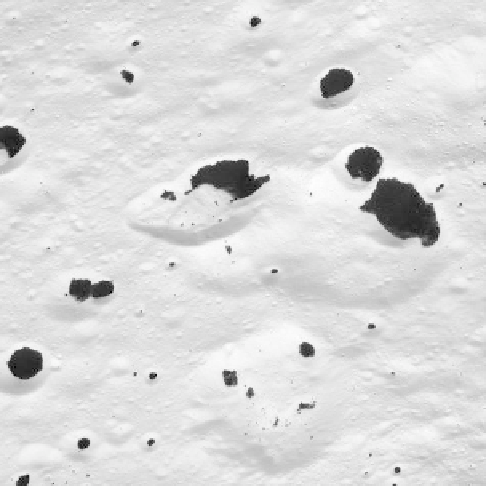Geology Reference
In-Depth Information
Figure 9.41. This huge landslide on Iapetus was derived from a 15 km
high wall of a 600 km impact basin and slid half-way across the
oor
of the 120 km crater seen in the middle of the image (NASA Cassini
PIA06171).
Figure 9.40. A mosaic of 60 Cassini images of Iapetus showing the
dark terrain of the leading hemisphere and the bright terrain of the
trailing hemisphere; the impact structure toward the south is
Engelier, a 450 km basin, one of many seen on this moon (NASA
PIA08384).
in diameter Thurgis. Large impact structures are also clearly
visible in the north polar area and in the trailing hemisphere
bright terrain, including the 504 km in diameter Engelier
(
Fig. 9.40
). Most of the large craters have central peaks and
well-de
ned rims. The lack of relaxation of the larger
craters suggests that a thick (50
-
100 km) ice lithosphere
was present early in Iapetus
history. Gradation in the form
ofmasswastingisseenonsomeofthesteepslopes
(
Fig. 9.41
).
The boundary between the bright and the dark terrain is
transitional. As seen in high-resolution Cassini images
(
Fig. 9.42
), crater
floors and other low-lying areas are
dark, giving the appearance of
“
pooled
”
material. The
frequency of the dark material increases toward the dark
terrain until the entire surface has the distinctive low
albedo.
Since the discovery of Iapetus by Giovanni Cassini in
1671 and study of its two-toned appearance telescopically,
there has been speculation on the cause of the albedo
dichotomy. Particularly controversial is the source of the
dark material, which is about as black as asphalt and is
thinner than ~0.5m. The generally accepted model is that
it is a lag deposit resulting from the sublimation of the icy
matrix that contains carbonaceous debris mixed with met-
allic iron and possibly dust derived from Phoebe, which
'
Figure 9.42. A Cassini image of the transition zone between the
bright and dark terrains of Iapetus, showing the concentration of
dark material in craters and other topographically low areas of the
surface; the area shown is 37 km across (NASA PIA08374).
would be preferentially implanted on the leading hemi-
sphere. In addition, because the polar regions are colder
than lower latitudes, the volatiles would migrate toward
the poles to form frost; with time, there would be a
positive feedback for the formation of the lag deposits in
which the dark areas would absorb more energy (causing
additional sublimation and concentration of dark lag),





